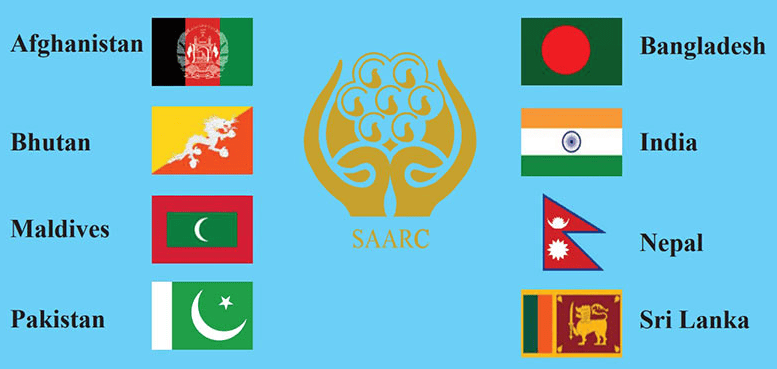SAARC | Political Science for CUET(PG) - CUET PG PDF Download
| Table of contents |

|
| Introduction |

|
| Objectives of SAARC |

|
| Principles of SAARC |

|
| Areas of Cooperation |

|
| Significance for India |

|
Introduction

South Asian Association for Regional Cooperation (SAARC) is an intergovernmental and international organization comprising countries in South Asia. Its members are Afghanistan, Bangladesh, Bhutan, India, the Maldives, Nepal, Pakistan, and Sri Lanka. As of 2019, SAARC represents 3% of the world's land area, 21% of the global population, and 4.21% of the world's economy. Established on December 8, 1985, in Dhaka, SAARC's headquarters are located in Kathmandu, Nepal. The organization focuses on enhancing economic and regional integration and launched the South Asian Free Trade Area in 2006. SAARC holds observer status at the United Nations and has developed relationships with multilateral entities, including the European Union.
Afghanistan joined SAARC as the newest member during the 13th annual summit in 2005. The association's headquarters and secretariat are situated in Kathmandu, Nepal.
Objectives of SAARC
- Enhance the well-being of South Asian people and improve their quality of life.
- Accelerate economic development, social progress, and overall improvement within the region, ensuring that individuals have the opportunity to live with dignity and reach their full potential.
- Promote and strengthen trust among South Asian countries.
- Foster mutual understanding and appreciation of each other's issues.
- Encourage active cooperation and mutual support in economic, social, and scientific fields.
- Strengthen collaboration with other developing nations.
- Enhance cooperation among member countries in international forums on matters of common interest.
- Collaborate with global and regional organizations with similar goals and objectives.
Principles of SAARC
SAARC operates based on the following principles:
- Cooperation within SAARC is founded on respect for the principles of sovereign equality, territorial integrity, political independence, non-interference in the internal affairs of other states, and mutual benefit.
- Such cooperation is intended to complement, rather than replace, bilateral and multilateral cooperation.
- Cooperation should be consistent with existing bilateral and multilateral obligations.
SAARC Members and Observers
The member countries of SAARC are:
- Afghanistan
- Bangladesh
- Bhutan
- India
- Maldives
- Nepal
- Pakistan
- Sri Lanka
Currently, SAARC has nine observer countries:
- Australia
- China
- European Union
- Iran
- Japan
- Republic of Korea
- Mauritius
- Myanmar
- United States of America
Areas of Cooperation
Areas of Cooperation
SAARC focuses on various areas of cooperation, including:
- Environment, Natural Disasters, and Biotechnology
- Economic, Trade, and Finance
- Social Affairs
- Information and Poverty Alleviation
- Energy, Transport, Science, and Technology
- Education, Security, Culture, and Other Areas
- Human Resource Development and Tourism
- Agriculture and Rural Development
Principal Organs
- Meeting of Heads of State or Government: These summit-level meetings are typically held annually.
- Standing Committee of Foreign Secretaries: This committee oversees monitoring, coordination, prioritization, resource mobilization, and project and financing approvals.
- Secretariat: Established in Kathmandu on January 16, 1987, the Secretariat coordinates and monitors SAARC activities, services meetings, and acts as a communication channel between SAARC and other international organizations. It is headed by the Secretary-General, appointed for a non-renewable three-year term on a rotational basis.
SAARC Specialized Bodies
- South Asian Regional Standards Organization (SARSO): Based in Dhaka, Bangladesh, SARSO aims to enhance coordination and cooperation in standardization and conformity assessment among member states to develop harmonized standards for regional trade and global market access.
- SAARC Arbitration Council: Located in Pakistan, this inter-governmental body provides a legal framework for the fair and efficient resolution of commercial, industrial, trade, banking, and investment disputes referred by member states and their citizens.
Importance of SAARC
SAARC encompasses 3% of the world’s land area, 21% of the global population, and 3.8% (US$2.9 trillion) of the global economy. The region, which is among the world’s most densely populated and fertile, shares common traditions, cultures, and political aspects, creating synergies for collective action. SAARC countries face shared challenges such as poverty, illiteracy, malnutrition, natural disasters, internal conflicts, and socioeconomic issues, necessitating common solutions and areas for development.
SAARC Development Fund (SDF)
- Objective: The SDF focuses on funding project-based collaboration in social sectors, such as poverty alleviation and development.
- Governance: The SDF is governed by a board comprising representatives from the Ministry of Finance of member states. The Governing Council, composed of the Finance Ministers of member states, oversees the board’s activities.
SAARC Achievements
- Free Trade Area (FTA): SAARC established a Free Trade Area to enhance internal trade and reduce trade gaps among member states.
- South Asia Preferential Trading Agreement (SAPTA): Effective since 1995, SAPTA aims to promote trade among member countries.
- SAARC Free Trade Agreement (SAFTA): This agreement focuses on goods (excluding services like IT) and aims to reduce customs duties to zero by 2016.
- SAARC Agreement on Trade in Services (SATIS): SATIS follows a GATS-plus ‘positive list’ approach for liberalizing trade in services.
- SAARC University: A SAARC university has been established in India, along with a food bank and an energy reserve in Pakistan.
Significance for India
- Global Leadership Role: SAARC provides India with a platform to demonstrate its regional leadership by assuming additional responsibilities.
- Advancement of Act East Policy: Connecting South Asian economies with Southeast Asia enhances economic integration and prosperity for India, particularly in the services sector.
- Neighbourhood First: Prioritizes relationships with neighboring countries.
- Geostrategic Importance: Helps counter China's One Belt One Road (OBOR) initiative by involving Nepal, Bhutan, the Maldives, and Sri Lanka in development and economic cooperation.
- Regional Stability: SAARC fosters mutual trust and peace within the region.
SAARC Regional Centres
Regional Centres, established in member countries, support the SAARC Secretariat in promoting regional cooperation. These Centres are managed by governing entities that include representatives from member states, the SAARC Secretary-General, and the host government’s Ministry of Foreign/External Affairs.
The Regional Integrated Programme of Action covers:
- Agriculture and Rural Development
- Women, Youth, and Children
- Health and Population Activities
- Science and Technology, and Meteorology
- Environment and Forestry
- Human Resource Development
- Transport
Working Groups focus on:
- Biotechnology
- Information and Communications Technology
- Intellectual Property Rights
- Energy
- Tourism
SAARC Summits
- 1st Summit: December 7-8, 1985, Dhaka, Bangladesh, attended by representatives from Bangladesh, Maldives, Pakistan, Sri Lanka, the kings of Bhutan and Nepal, and the Prime Minister of India.
- 2nd Summit: November 16-17, 1986, Bangalore, India, where the Memorandum of Understanding for the SAARC Secretariat was signed.
Recent SAARC News
- The Indian Ministry of External Affairs announced plans to provide COVID-19 vaccines to SAARC nations as grant assistance.
- SAARC member countries recently rejected Pakistan's proposal to host the upcoming summit.
- Indian Foreign Minister S. Jaishankar highlighted cross-border terrorism, obstructed trade, and blocked connectivity as key challenges for SAARC.
- Nepal’s Foreign Minister Pradeep Gyawali urged SAARC members to explore options for convening the 19th summit and to enhance regional cooperation to address COVID-19 and build resilience.
- India’s proposal to establish a COVID-19 Emergency Fund received positive responses from SAARC nations, with all but Pakistan contributing.
- In January 2021, India’s Ministry of External Affairs announced plans to supply COVID-19 vaccines to key SAARC member countries in phases.
SAARC Summit Hosts and Dates
- 1st Summit: December 7-8, 1985, Dhaka, Bangladesh, hosted by Ataur Rahman Khan
- 2nd Summit: November 16-17, 1986, Bangalore, India, hosted by Rajiv Gandhi
- 3rd Summit: November 2-4, 1987, Kathmandu, Nepal, hosted by King Birendra Bir Bikram Shah
- 4th Summit: December 29-31, 1988, Islamabad, Pakistan, hosted by Benazir Bhutto
- 5th Summit: November 21-23, 1990, Male, Maldives, hosted by Maumoon Abdul Gayoom
- 6th Summit: December 21, 1991, Colombo, Sri Lanka, hosted by Ranasinghe Premadasa
- 7th Summit: April 10-11, 1993, Dhaka, Bangladesh, hosted by Khaleda Zia
- 8th Summit: May 2-4, 1995, New Delhi, India, hosted by P.V. Narasimha Rao
- 9th Summit: May 12-14, 1997, Male, Maldives, hosted by Maumoon Abdul Gayoom
- 10th Summit: July 29-31, 1998, Colombo, Sri Lanka, hosted by Chandrika Kumaratunga
- 11th Summit: January 4-6, 2002, Kathmandu, Nepal, hosted by Sher Bahadur Deuba
- 12th Summit: January 2-6, 2004, Islamabad, Pakistan, hosted by Zafarullah Khan Jamali
- 13th Summit: November 12-13, 2005, Dhaka, Bangladesh, hosted by Khaleda Zia
- 14th Summit: April 3-4, 2007, New Delhi, India, hosted by Manmohan Singh
- 15th Summit: August 1-3, 2008, Colombo, Sri Lanka, hosted by Mahinda Rajapaksa
- 16th Summit: April 28-29, 2010, Thimphu, Bhutan, hosted by Jigme Thinley
- 17th Summit: November 10-11, 2011, Addu, Maldives, hosted by Mohamed Nasheed
- 18th Summit: November 26-27, 2014, Kathmandu, Nepal, hosted by Sushil Koirala
- 19th Summit: November 15-16, 2016, Islamabad, Pakistan (Cancelled)
20th SAARC Summit
The 20th SAARC Summit was scheduled to be the next meeting of the heads of state or government of the eight SAARC member countries following the previous summit in Islamabad, Pakistan. However, it was canceled due to an attack on an Indian army camp in Uri, Jammu and Kashmir. India boycotted the summit, accusing Pakistan of involvement in the attack. Subsequently, Bangladesh, Afghanistan, and Bhutan also withdrew from the summit.
SAARC Leadership and Membership
- 1st Secretary-General of SAARC: Abul Ahsan (Bangladesh)
- Current Secretary-General: Esala Ruwan Weerakoon (Sri Lanka), who has been in office since March 1, 2020
Membership and Headquarters
- Most Recent Member to Join: Afghanistan (April 2007)
- Last SAARC Summit: The 19th Summit in Pakistan was canceled
- SAARC Headquarters: Kathmandu, Nepal
SAARC Satellite
- Launch: The SAARC Satellite for South Asia was launched in 2017
FAQs on SAARC - Political Science for CUET(PG) - CUET PG
| 1. What are the main objectives of SAARC? |  |
| 2. What principles guide the functioning of SAARC? |  |
| 3. In which areas does SAARC focus on cooperation? |  |
| 4. Why is SAARC significant for India? |  |
| 5. How does SAARC contribute to regional integration in South Asia? |  |















